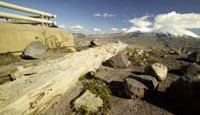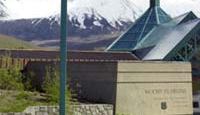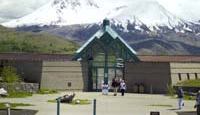 |

|
 |
 |
The entire approach to the Mount St. Helens Volcanic Monument was conceived of as a 60-plus mile ecclesiastical journey. From the highway approach “nave,” to the visitors complex “transept,” and the metaphorical terminus at the crater “apse,” visitors undertake a journey that is ultimately and explicitly more powerful than themselves (photo: CALA/Charles Anderson Landscape Architecture). |
 |
 |
 |
 |
 |
Like modern day pilgrims, visitors flock to the prow of the Johnston Ridge Volcano Observatory, which feels like a teetering altar. This proscenium stage provides an unparalleled setting for contemplation of the beauty of the devastation beyond (photo: USFS/United States Forest Service). |
 |
 |
 |
 |
 |
In plan, the Coldwater Ridge Visitors Center is organized around a ridge rim arc with an arrow orienting visitors toward the crater and piercing its heart (photo: CALA/Charles Anderson Landscape Architecture). |
 |
 |
 |
 |
 |
Within the construction envelope, ejected debris was catalogued and later replaced in its original location. Boulders cast from the mountain and blown down trees are compass needles pointing away from the crater’s devastating force, while the site interventions orient viewers directly toward the crater (photo: Andrew Buchanan). |
 |
 |
 |
 |
 |
The building entry features fractured pavement and specially designed light elements that are reminiscent of the once towering trees that now lay scarred and prostrate on the ground (photo: Andrew Buchanan). |
 |
 |
 |
 |
 |
From 1993, when it opened to the public, to 2005, plant life at the Coldwater Ridge Visitors Center has slowly returned. It is a gradual, delicate process that speaks volumes about the fragility of the landscape (photo: EDAW/Strode-Eckert Photography). |
 |
 |
 |
 |
 |
A spring 2005 view of the main entrance to the Coldwater Ridge Visitors Center provides an indication as to how an entire alpine ecology dominated by lupine, penstemon and fireweed has established a strong foothold (photo: Andrew Buchanan). |
 |
 |
 |
 |
 |
 |
 |
 |
 |
 |
|
|
 |
 |
 |
GENERAL DESIGN AWARD OF HONOR
Mount St. Helens National Volcanic Monument, Coldwater/Johnston
Recreation Complex, Castle Rock, WA
Charles Anderson Landscape Architecture, Seattle, WA
EDAW, Inc., Seattle, WA
USDA Forest Service, Vancouver, WA
|
 |
 |
When the snowy cathedral of Mount St. Helens erupted on
May 18, 1980, the world witnessed the terribly beautiful and surreal
speed with which a pristine wilderness could be transformed
into a paradoxical and enigmatic landscape. This May, 25 years
later, Mount St. Helens demands our attention as the mountain
rebuilds and pilgrims flock to the Forest Service facilities
at Coldwater Ridge and Johnston Ridge to once again bear witness
to the mountain’s majestic fury.
Conceived on a master plan level as a 60-mile ecclesiastic
experience, visitors enter the “church” upon exiting
Interstate 5 onto the new road leading to the monument. This
central "nave"—long, narrow, atoning—prepares
visitors for the crater-cum-altar within the conceptual "transept"
of the blast zone where the two facilities are located. The
immolated past is laid bare in this surreal landscape of prostrate
trees, denuded soils, and funereal memorials. The continuation
of the spiritual journey—from earth to ether—is
purely a metaphorical construct, yet standing on the fractured
prow of the Johnston Ridge Observatory while confronting the
apse (crater), visitors are connected to the powerful, terrifying
and, ultimately, deeply beautiful face of the unknown.
For many of the survivors who experienced the mountain’s
power, the memory is more emotion than experience. It was
this primal wellspring that provides the foundation for the
site design at both locations: awe, fear, joy, terror, reverence.
Fractured pavement gives the feel of a burnt, unstable firmament.
Custom light poles read as stripped but standing tree trunks
during the day and become illuminating beacons at night. There
is also the psychological perception of permanence. Rather
than terraced landforms to accommodate the seasonal crush
of vacationers, the designers approached parking as a buried
ruin that was dug out from beneath the blast debris and ash.
It was a counter-intuitive move that lead to the massive earthwork
creation of a plateau for parking using the cut material from
the new highway’s construction. These moves also met
the goals of the collaboration between the public and private
sector clients: an interdisciplinary design that was deferential
to the mountain and its resources, yet evocative and expressive
in its own right.
T he Coldwater Ridge Visitors Center takes the crescent shape
of the volcano and imposes an arrow oriented to the crater.
A network of paths thread visitors through the devastated
cloisters where great trees once stood and overlooks provide
moments of pause and praise. Here, and at the Johnston Ridge
Observatory further on, planting design was conducted with
an restrained hand. Life, here, is delicate and primeval;
a precarious balance that was part brownfield and part intensive
ecological restoration. For these reasons the majority of
the site was left to sustain and succeed on its own—as
a laboratory where life, once tenuous, was now spreading its
tendrils slowly. Where plantings were justified, the designers
specified only plants that were growing within the monument.
Even the blown down logs and "volcanic bombs" (superheated
boulders that flew up to eight miles from the eruption landed
and split apart) were cataloged and returned to the construction
envelope.
Both memorial and monument, the Johnston Ridge Observatory
poignantly displays the drama of the destruction and becomes
the visitor’s penultimate experience along the emotional/spiritual
journey through the metaphor of a resting butterfly. The butterfly
is a symbol of beauty, delicacy, and durability. It is a creature
that quickly returned to the devastated landscape and symbolizes
the vital forces of this landscape. The butterflies returned
without memory of the eruption, seeking the nectar of the
lupines, penstemons, and fireweed that were quick to cover
the blast zone.
Human visitors return to the site seeking another type of
sustenance. So that visitors may concentrate on the power
of the mountain, the design deliberately minimized the view
of the road and parking area from the observatory. Moving
from drop off to the earth-sheltered observatory, visitors
walk an ash-laden arc that has been sliced through the ridge.
Both allegorical and functional, the meander of this trail
pushes visitors further outside traditional zones of comfort
in anticipation of the proscenium thrust of the mountain.
The volcano emerges from beyond the balcony overlook, which
drops down slightly to increase the sense of liminal imbalance
and uncertainty. With a 2,000 foot drop and the looming mountain
just five miles distant, the choreography of the landscape
ends on a teetering altar.
Rather than inciting fear for disingenuous reasons, the designers
have delicately balanced the extant power of the mountain
to awe and inspire with the human desire to connect with a
power beyond themselves. The spaces bow to and highlight an
omnipotence only imagined 25 years ago. At the same time,
they continue to inspire visitors through emotional awe and
a deeply-resonant respect that reveals both the brutal and
delicate processes of survival, regeneration and reformation.
|
|
|
|
 |
 |
 |
|
 |